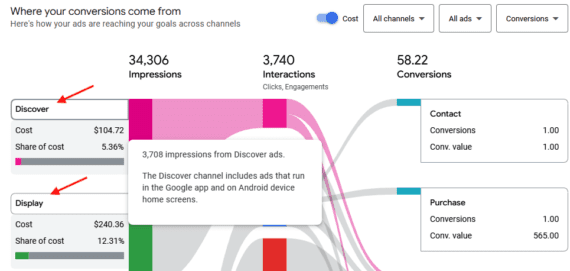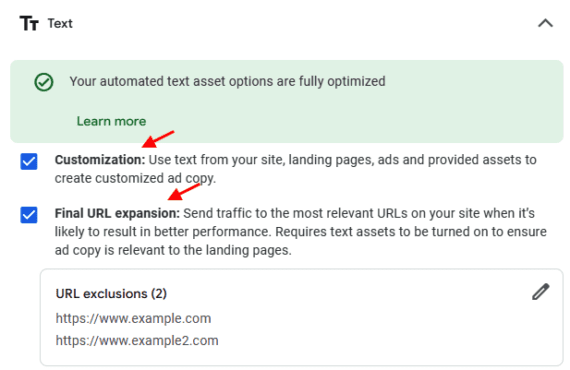Google’s Performance Max campaigns place responsive ads across all Google channels based on audience signals. The search giant automatically determines an ad’s headlines, descriptions, and images across, say, Search, Display, and YouTube to deliver top results.
Yet PMax campaigns lack transparency and restrict options.
The encouraging news is that Google is listening to advertisers and has rolled out PMax reporting and flexibility updates in the past year. These include reports for asset-level conversions and Search category theme volume and conversions, as well as the ability to exclude devices where your ads can appear.
More recently, Google has provided new PMax optimization features. I’ll address those in this post.
Channel performance
Table of Contents
At a Performance Max campaign level, advertisers can now see which channels drive traffic and conversions. In the example below, traffic from Google Discover accounts for 5.36% of total spend and one conversion.

Performance Max advertisers can now see, at the campaign level, which channels drive traffic and conversions. Click image to enlarge.
Performance Max ads can show in these Google channels:
- Discover
- Display
- Gmail
- Maps
- Search
- YouTube
Advertisers cannot exclude specific channels, but the new visibility is helpful and may determine PMax’s overall viability. Advertisers can exclude non-converting ads and keywords to assess further whether PMax is the right option.
Final URL expansion
By default, new Performance Max campaigns turn on Final URL expansion. This means that Google can send searchers to a different landing page for better conversions. Expanding the Final URL can be worthwhile, but it’s important to see which pages are converting. An option in the “Assets” tab provides the Final URL expansion assets.
Advertisers can exclude irrelevant URLs in “Asset Optimization” within the campaign settings. Click on the “Customization” option to activate “Final URL expansion.”

Advertisers can exclude irrelevant URLs in “Asset Optimization” within the campaign settings. Click image to enlarge.
Asset Optimization
Speaking of Asset Optimization, advertisers can see the asset source for the many components of Performance Max data. For example, a Google-created headline may convert at twice the rate of an advertiser’s version. Advertisers can pause automatically created assets, similar to pausing keywords.
Advertisers can disable automated assets at the account level, but not for campaigns. Turn off the option, for example, if you don’t want Google-created sitelinks to show. Remember that turning off an automated asset impacts the entire account.
Negative keywords
Performance Max campaigns have always allowed negative keywords. However, the setup was cumbersome, requiring either implementation by a Google rep or the creation of an account-level negative keyword list.
Now, adding negative keywords is easy. Discovering the keywords is also easy, as search queries are available as a separate option in the “Insights and reports” tab to view the data and select terms to exclude.
Search Themes
Google introduced Search Themes in 2023 to help guide its AI. The Themes work similarly to keywords. For example, a retailer selling winter jackets could provide Search Themes of:
- “Winter jackets,”
- “Men’s winter jackets,”
- “Women’s winter jackets,”
Searchers don’t need to type these keywords for ads to show. Instead, the ads show if an advertiser’s site content or the searcher’s query history indicates relevance. Along with audience signals, Search Themes helps Google know a searcher’s profile.
Google now allows up to 50 Search Themes per asset group, an increase from 10.





